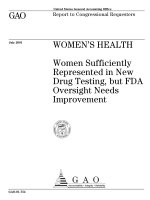Tài liệu Women’s health in prison Correcting gender inequity in prison health ppt
Bạn đang xem bản rút gọn của tài liệu. Xem và tải ngay bản đầy đủ của tài liệu tại đây (432.97 KB, 65 trang )
Women’s health in prison
Correcting gender inequity in prison health
2009
ABSTRACT
In 1995, the WHO Regional Office for Europe launched the Health in Prisons Project, supported by the WHO
Collaborating Centre for Health and Prisons in the Department of Health, United Kingdom. The Project
works
within a network of countries committed to protecting and promoting health in prisons in the interests of prisoners,
of staff and of public health. The network combines shared experience wit
h expert advice to produce guidance for
countries wishing to improve health care and circumstances in their prisons and, in particular, to develop their role
in preventing the spread of disease. The network aims to maximize an important opportunity for pro
moting health
in a marginalized group and contributing to general public health in their communities.
At the request of the
Member States involved, the WHO Health in Prisons Project, together with partner organizations and experts and
with the support of the United Nations Office on Drugs and Crime,
the Quaker Council for European Affairs, the
Quaker United Nations Office, the Sainsbury Centre for Mental Health, the AIDS Foundation East-West and
the
European Monitoring Centre for Drugs and Drug Addiction, h
as reviewed all issues affecting women’s health in
the criminal justice system and has especially considered the gross inequities in women’s health in prisons. The
Project has adopted the enclosed declaration and background paper as evidence fully justifyi
ng the
recommendations and call for action in its conclusion.
Keywords
PRISONS
PRISONERS
WOMEN’S HEALTH
EUROPE
EUR/09/5086974
Address requests about publications of the WHO Regional Office for Europe to:
Publications
WHO Regional Office for Europe
Scherfigsvej 8
DK-2100 Copenhagen Ø, Denmark
Alternatively, complete an online request form for documentation, health information, or for permission to quote or translate, on the
Regional Office web site (
Address requests about publications of the WHO Regional Office for Europe to:
Publications
WHO Regional Office for Europe
Scherfigsvej 8
DK-2100 Copenhagen Ø, Denmark
Alternatively, complete an online request form for documentation, health information, or for permission to quote or translate, on the
Regional Office web site (
© World Health Organization 2009
All rights reserved. The Regional Office for Europe of the World Health Organization welcomes requests for permission to
reproduce or translate its publications, in part or in full.
The designations employed and the presentation of the material in this publication do not imply the expression of any opinion
whatsoever on the part of the World Health Organization concerning the legal status of any country, territory, city or area or
of its authorities, or concerning the delimitation of its frontiers or boundaries. Dotted lines on maps represent approximate
border lines for which there may not yet be full agreement.
The mention of specific companies or of certain manufacturers’ products does not imply that they are endorsed or
recommended by the World Health Organization in preference to others of a similar nature that are not mentioned. Errors and
omissions excepted, the names of proprietary products are distinguished by initial capital letters.
All reasonable precautions have been taken by the World Health Organization to verify the information contained in this
publication. However, the published material is being distributed without warranty of any kind, either express or implied.
The responsibility for the interpretation and use of the material lies with the reader. In no event shall the World Health
Organization be liable for damages arising from its use. The views expressed by authors, editors, or expert groups do not
necessarily represent the decisions or the stated policy of the World Health Organization.
iii
C
C
o
o
n
n
t
t
e
e
n
n
t
t
s
s
Foreword v
Acknowledgements vii
Kyiv Declaration on Women’s Health in Prison 1
Introduction 9
Need for a declaration on women’s health in prison 9
Objectives of a declaration on women’s health in prison 10
Definitions 10
Women, prison and society 12
Facts and figures 12
Human rights standards and international conventions 13
Women in prison and society 16
Women’s health and prison 21
Need for gender-specific health care 21
Organization of health care services for women in prison 22
HIV, hepatitis C and other infectious diseases 23
Substance use 25
Mental health and mental ill health 27
Self-harm and suicide 29
Learning disabilities 30
Sexual health and reproductive health 30
Pregnancy, postnatal care and breastfeeding 32
Violence and abuse 33
Multiple and complex treatment needs 35
Pre-release preparations and continuity of care after release 36
How can the situation be improved? What can, should and must be done? 39
Recent developments and emerging plans 40
Recommendations 42
Concluding remarks 50
References 51
iv
v
Foreword
Prison policies often overlook the special needs of women and their health. Many women in
prison have high levels of mental illness and drug or alcohol dependence as well as histories of
sexual and physical abuse and violence. Issues arising from gender-specific health care needs
and family responsibilities are also frequently neglected. Although women represent a small
percentage of the total prison population, their numbers are increasing and the rate of increase is
much greater than that of men.
The rise and rapid spread of HIV infection, the resurgence of other serious communicable
diseases such as tuberculosis and hepatitis and the increasing recognition that prisons are
inappropriate receptacles for people with drug or alcohol dependence and mental health
problems have thrust prison health high on the public health agenda. As WHO has emphasized,
any national health strategy must include prison policies that address these serious health
problems.
Health is a fundamental human right, especially for individuals held in the custody of the state.
Although women should be entitled to the same rights as men, prison systems were primarily
designed for men, and many prisons do not have adequate facilities to protect women’s rights or
to promote their health. Compounding the difficulty of addressing this problem is the lack of data
and research about women’s health status while in prison. Health systems must include
penitentiary health policies that integrate women’s health needs in all phases of planning and
implementation.
Since 1995, the WHO Regional Office for Europe has been committed to reducing the public
health hazards associated with prisons and protecting and promoting health in prisons. Regional
Office reports such as the 2007 Health in prisons: a WHO guide to the essentials in prison health
have combined the latest research and analysis from experts in the field and have raised the
profile of prison health issues. Building on the WHO Gender Policy, the Regional Office has
supported research to develop evidence-based guidance on the major aspects of women’s health
in connection with prisons and the criminal justice system as a whole.
vi
The principles and recommendations of the Kyiv Declaration on Women’s Health in Prison are
important steps towards improving health systems and addressing the health needs of women
involved in the criminal justice system. I hope that this report, which outlines the evidence and
the expert opinions considered at the special conference held in Kyiv in November 2008, will
convince all Member States to adopt and implement the Kyiv Declaration in fulfilment of their
commitment to human rights and health promotion for all.
Nata Menabde
WHO Deputy Regional Director for Europe
vii
Acknowledgements
We would like to thank the following experts for their valuable contributions to this publication.
• Isabel Yordi Aguirre, WHO Regional Office for Europe
• Tomris Atabay, Justice and Integrity Unit, United Nations Office on Drugs and Crime,
Vienna, Austria
• Mark Bellis, Coordinating Centre for the Work Strand on Violence and Health,
University of Edinburgh, Scotland, United Kingdom
• Rachel Brett, Quaker United Nations Office, Geneva, Switzerland
• Michael Browne, Healthcare and Drug Strategy, HMP and YOI Holloway, London,
United Kingdom
• Ingrid Lycke Ellingsen, Prison Health Expert Group, Northern Dimension Partnership in
Public Health and Social Well-being, Norway
• Andrew Fraser, Collaborating Centre for Prison Health, Scottish Prison Service, United
Kingdom
• Mignon French, Women Offenders’ Health, Department of Health, London, United
Kingdom
• Alex Gatherer, Health in Prisons Project, WHO Regional Office for Europe
• Fabienne Hariga, HIV and AIDS Unit, United Nations Office on Drugs and Crime,
Vienna, Austria
• Paul Hayton, Collaborating Centre for Prison Health, Department of Health, London,
United Kingdom
• Dagmar Hedrich, European Monitoring Centre for Drugs and Drug Addiction, Lisbon,
Portugal
• Rachel Hunter, Women Offender’s Health, Department of Health, London, United
Kingdom
• Natalya Kalashnyk, State Department on Enforcement of Sentences, Kyiv, Ukraine
• Morag MacDonald, Women’s Offender Health Research Interest Group, Birmingham
City University, United Kingdom
viii
• Ruth Elwood Martin, Clinical Professor, Vancouver Foundation Community Based
Clinician Investigator, Vancouver, Canada
• Lesley McDowall, Healthcare, HMP and YOI Cornton Vale, Scottish Prison Service,
United Kingdom
• Nick McGeorge, Quaker representative, United Nations Commission on Crime
Prevention and Criminal Justice
• Sheila McNerney, Leeds Chlamydia Screening Programme, Leeds, United Kingdom
• Katherine Moloney, WHO Regional Office for Europe
• Liz Scurfield, Quaker Council for European Affairs, Brussels, Belgium
• Mia Spolander, United Nations Office on Drugs and Crime, Vienna, Austria
• Nancy E. Stoller, Department of Community Studies, University of California, Santa
Cruz, United States of America
• Laura Thorne, Prisons and Criminal Justice, Sainsbury Centre for Mental Health,
London, United Kingdom
• Corey Weinstein, American Public Health Association, Washington, DC, United States
of America.
Our special thanks go to Alex Gatherer for his tremendous help and support in drafting this
publication.
We are very grateful to the Quaker Council for European Affairs for their financial contribution
to a Round Table on Women’s Health in Prison in June 2008 and to the Collaborating Centre on
Prison Health for hosting the Round Table in the premises of the Department of Health in
London, United Kingdom in June 2008.
Lars Møller, Manager, Health in Prisons Project
Brenda van den Bergh, Technical Officer, Health in Prisons Project
WHO Regional Office for Europe
1
Kyiv Declaration on Women’s Health in Prison
1. We, the government-recognized representatives of ministries concerned with health in
prisons, the WHO Collaborating Centre in the Department of Health, United Kingdom,
representatives of the United Nations Office on Drugs and Crime, the Quaker Council for
European Affairs, the Quaker United Nations Office, the Sainsbury Centre for Mental
Health, the AIDS Foundation East-West and other international organizations with expert
knowledge of health in prisons throughout Europe and in the United States of America, note
with concern that current arrangements in criminal justice systems for dealing with women
offenders often fail to meet their basic and health needs and are therefore far short of what is
required by human rights, by accepted international recommendations and by social justice.
2. We have been made aware that the facts concerning women in prison are complex and
challenging and can make addressing their health needs very difficult.
• While women constitute a very small proportion of the general prison population (the
median level in Europe is 4.9%, with high variation between countries) the recent rate of
increase in the number of women in prison is greater than that for men. In Europe, there
are about 100 000 women in prison every day.
• The majority of offences for which women are imprisoned are non-violent, property or
drug-related, and many women serve a short sentence, which means that the turnover rate
is high.
• As women in prison are frequently victims of physical and sexual abuse, prison
authorities and custodial staff should promote their dignity and safety and protect women
in prison from bullying and abuse of any type. Male custodial officers should not be
responsible for the direct supervision of women. They should never have routine physical
contact with them, or have access to living and bathroom areas.
2
• The number of women held in pre-trial detention in many countries is equivalent to or
even larger than the number of convicted female prisoners. Pre-trial detainees may have
limited contact with other prisoners, fewer opportunities for health care and vocational or
job programmes, and restrictions on family contact including visits, which
disproportionately affects women with children as well as the children themselves.
• The prevalence of mental health problems is high among women in prison, and these
problems are infrequently addressed adequately. Post-traumatic stress disorder and
substance use disorder affect the majority of female prisoners. Women in prison are more
likely to self-harm and commit suicide than male prisoners.
• A large proportion of women in prison have experienced a lifetime of victimization,
including child abuse, neglect and domestic violence. There is a close link to the
woman’s criminogenic pathway and her mental and physical illness.
• Since foreign national women, girls and older women in prison are minority groups
within a minority of the prison population, their needs are easily overlooked.
• Due to the small numbers of women in prison, countries generally only have a few prison
facilities for women. Women are therefore often placed far from home, which further
strains family ties.
• Many women in prison are mothers and usually the primary or sole carer for their
children. It is estimated that, in Europe, around 10 000 babies and children younger than
two years of age are affected by their mother’s imprisonment. When considering all
children younger than 18 years old, the number affected by their mother’s imprisonment
is much higher, counting hundreds of thousands.
• When women give birth or have care of a baby while in prison, it is important to have a
regime that allows the mother to nurture and bond with her child. The age until which
3
children can stay with their mothers in prison varies widely across Europe. Three years is
the most common age limit.
• The prevalence of HIV, other bloodborne diseases and sexually transmitted infections
among women prisoners is often higher than among male prisoners.
• There is a lack of objective, reliable and comparable information about drug use
prevalence and risk behaviour and about service needs and provision to women in prison
that could inform the planning of adequate health services (including drug treatment) and
support an evaluation of their quality and effectiveness.
3. We accept that the evidence clearly shows unacceptable gaps and deficiencies in many parts
of Europe.
• The prison environment does not always take into account the specific needs of women.
This includes the need for adequate nutrition, health and exercise for pregnant women
and greater hygiene requirements due to menstruation such as the availability of regular
showers and sanitary items that are free of charge and may be disposed of properly.
• Mental illnesses, including drug problems and traumatization, are infrequently addressed.
There are shortcomings in recognized standards of evidence-based treatment such as
substitution therapy, psychotherapy, counselling, training, peer support and harm-
reduction measures.
• There are often deficiencies in the provision of training provided to prison staff. Gender-
sensitive training and training on the specific health needs of women in prison should be
widely available in all systems.
4
• There is a challenge in many prison systems to balance respect for and the dignity of the
woman in prison with surveillance and security in the prison while providing care and
treatment.
• It is not uncommon for women in prison to discover at the same time that they are
pregnant and HIV infected. The mental burden of being in prison, having a new
pregnancy and discovering HIV infection can be devastating for the woman, and this is
seldom adequately addressed in custodial environments.
• The provision of an effective system of prison inspection and oversight carried out by an
independent body and with a confidential complaint system is essential in preventing
violence and abuse within the prison. Such systems are often lacking.
• Prison policies and programmes are seldom specifically tailored to the needs of women,
especially in the vital area of pre-release programmes and resettlement.
• Pre-release interventions, including interventions specifically aimed to reduce the acute
risk of drug-related death among women prisoners in the first weeks after their release,
are very important but often do not take place.
• Continuity of care (throughcare) upon release is of utmost importance and should be the
responsibility of prison staff, health care staff and social care authorities in the
community together, but this continuity of care is often not guaranteed.
4. We fully support this Kyiv Declaration and undertake through our various channels to
draw the attention of governments and policy-makers to the key recommendations that
follow.
Member States at the government and policy-making levels should urgently review their
current policies and services for meeting the basic and preventive and curative health (care)
5
needs of women at all stages of criminal justice systems and, where necessary, introduce
changes to meet the following.
4.1 The underlying importance of human rights should underpin all thinking and all policy
development for all those in compulsory detention.
4.2 The important principles that should be followed in deciding what should be done to
improve current practice should include the following.
• Pre-trial detention and imprisonment should be used as a last resort in the cases of
women who have committed non-violent offences and who do not pose risk to the
society. The imprisonment of pregnant women and women with young children should
be reduced to a minimum and only considered when all other alternatives are found to be
unavailable or are unsuitable.
• All policies affecting women in the criminal justice system must recognize the gender-
specific needs of women and the significant variation in need that can exist between
different groups of women.
• Health service provision and programming should specifically address mental illness, in
particular substance use disorders and post-traumatic stress disorder. This is
essential to any prison health care system.
• If children are involved, the best interest of the children must be the main and
determining factor in decisions regarding women’s imprisonment, including putting the
needs of the children first when considering whether and for how long the children
should stay with their mother in prison.
• Health service provision in prison must recognize women’s gender-specific health care
needs and should be individualized, framed and delivered in a holistic and humane
manner.
6
4.3 Key services to be provided should include:
• comprehensive and detailed screening when first admitted to prison and regularly
throughout their stay; this should cover socioeconomic and educational background,
health and trauma histories, current health status and an assessment of skills held or
required;
• an individualized care, treatment and development plan, to be prepared by joint effort
between different health care providers and all other staff likely to be involved in a
woman’s care and custody in consultation with the women themselves;
• primary health care services provided in the prison, which are outlined to the woman
during the important induction period; her rights to access, including emergency access,
to confidentiality, to privacy and to health information and promotion activities, should
be made clear, preferably by means of an easily understandable written pamphlet;
• specialist health care, which is readily provided and adjusted to meet the needs of
women, such as for mental health, including help with a legacy of abuse and post-
traumatic stress disorder; chronic health conditions, HIV and AIDS including counselling
and support, hepatitis, tuberculosis and other infectious diseases; drug and alcohol
dependence; learning disabilities; and reproductive health, with access to specialist health
care being explained to the woman in prison when discussing her individual care plan;
and
• pre-release preparations that are adequately planned and provided in order to
ensure continuity of care and access to health and other services after release; health
and social care cannot be provided in isolation from community services; just as health
and nursing staff must maintain professional contacts with their peer groups, so must all
services within prisons have good links to the equivalent services in the community.
7
4.4 The above services and approaches are likely to succeed only if the role of governments,
policy-makers and senior management is understood, accepted and applied. In broad
terms, this requires:
• that the criminal justice system be seen to be serving the interests of women in their care,
so that gender-specific health and other needs are readily met and easily accessed;
• that every prison that is required to house women prisoners have a written policy showing
that the practices in that prison are sensitive to the special needs of women and that the
staff have undergone gender-sensitive training; and
• that where and whenever children are involved, their needs and best interests be clearly
seen as the first and main consideration in what is provided for them.
5. We have agreed to collaborate with the WHO Health in Prisons Project and its partners so
that, over the next three years, guidance on the implementation of this Declaration will be
produced from the experiences gained from the initiatives and good practices already
underway in different parts of the WHO European Region and made available to all countries
in Europe. Within their respective mandates, WHO, the United Nations Office on Drugs and
Crime and the European Monitoring Centre for Drugs and Drug Addiction will cooperate to
improve the monitoring of prison health, including drug addiction issues. We will consider
how we can assist all countries in monitoring progress towards better, fairer and more
gender-sensitive services, made available for women in all parts of the criminal justice
system.
8
9
Introduction
Need for a declaration on women’s health in prison
As prison sentences have been designed for men and by men, women are always an exception. It is a
challenge to find special solutions to meet the needs of imprisoned women.
(Kurten-Vartio, 2007)
Women constitute a special group within prisons because of their sex. Although the
characteristics and corresponding needs of women prisoners can vary considerably between
countries, several factors are common to most. These include many mental disorders, a high
level of drug or alcohol dependence, many women experiencing sexual and physical abuse and
violence before or in prison, the neglect of gender-specific health care needs and additional
issues related to the women’s responsibility for children and families. Many women in prison
have young children for whom they were often the primary or sole carer before they entered
prison.
Women’s rights while in prison are the same as men’s rights, but women seldom have equal
access to these rights. As prison systems have been primarily designed for men, who comprise
more than 95% of the prison population in most countries, prison policies and procedures often
do not address women’s health needs. Data on the health of women in prison and the health care
provided for them are rare, because most prison data are not gender specific.
The health status of prisoners is generally much poorer than that of the general population, and
women’s health needs can be seriously neglected in a male-dominated prison system. Many
women in prison have a background of physical and sexual abuse and of alcohol and drug
dependence. Many did not receive adequate health care before incarceration. Women in prison
generally have more mental health problems than women in the general population. This
frequently stems from prior victimization. Mental illness is often both a cause and a consequence
of imprisonment and the rates of self-harm and suicide are noticeably higher among female than
among male prisoners. Both rates are higher than in the outside community.
10
It is often ignored that imprisoning women has greater social cost to family and community than
does imprisoning most men prisoners. Family breakdown, long-term problems among children
taken into care and a loss of community spirit and cohesion can push the social costs of women’s
imprisonment considerably higher than for men’s imprisonment.
This is a background paper for the Kyiv Declaration on Women’s Health in Prison, which was
discussed and adopted during the WHO International Conference on Prison Health in November
2008.
The paper reflects the evidence from literature research and the best evidence provided by
experts on women’s health in prison, who are listed under acknowledgements.
Objectives of a declaration on women’s health in prison
The objectives of a declaration on women’s health in prison are:
1. to raise awareness among the countries within the WHO European Region of the current
situation regarding the health of and health care provided for women in European prisons;
2. to call for marked improvements in the current situation by the implementation of WHO
recommendations for:
a general approach that creates a more acceptable and gender-sensitive criminal justice
system, with special attention to the rights of any women and children involved;
the amount and quality of health care to be provided within prisons, which should be at
least broadly equivalent to the health care provided in the community; and
the establishment of satisfactory methods for ensuring the continuity of care.
Definitions
The following definitions apply in this paper.
Foreign national prisoner: a person who is neither a legal citizen nor a permanent resident of
the country in which he or she is being held in prison.
11
Girl: a female person younger than 18 years of age.
Older woman: a female person 50 years or older.
Prison: a place of compulsory detention in which people are confined while on remand awaiting
trial, on trial or for punishment following conviction for a criminal offence (not including police
cells).
Prisoner: a person held in prison, awaiting trial or serving a prison sentence.
Woman in prison: a female person of at least 18 years old, held in prison, awaiting trial or
serving a prison sentence.
Women’s health: a state of “complete mental, physical, spiritual and social well-being” for all
female infants, girls and women regardless of age, socioeconomic class, race, ethnicity and
geographical location.
12
Women, prison and society
This section contains scientific evidence and recommendations by international health agencies,
scholars and other experts on the health of women in prison.
Facts and figures
1. More than half a million women and girls are held in prisons throughout the world, either as
remand or sentenced prisoners. In Europe, about 100 000 women and girls are in prison
(United Nations Office on Drugs and Crime, 2008). Women constitute a very small
proportion of the general prison population worldwide, usually between 2% and 9% of a
country’s prison population. Only 12 prison systems worldwide report a higher percentage
than that. The median level in Europe is 4.4%. In Europe, Spain has the highest percentage of
women in prison (almost 8%) and Azerbaijan the lowest (less than 1.5%) (Walmsley, 2006;
WHO Regional Office for Europe, 2009).
2. Although women are a minority in national prison populations all over the world, the female
prison population is increasing. This increase in women’s imprisonment is part of a global
trend towards the increasing popularity and use of imprisonment and a corresponding under-
use of constructive alternative, non-custodial sanctions. This applies particularly to drug
offences and non-violent theft (Penal Reform International, 2007). Most female drug
offenders could be dealt with more effectively by alternatives to imprisonment specifically
targeting the drug problem rather than by imprisonment (United Nations Office on Drugs and
Crime, 2008). Further, the rate of increase in the number of women in prison is much greater
than that for men (Bastick, 2005). For instance, in England and Wales, the number of women
in prison has increased by more than 200% in the past 10 years versus a 50% increase in the
number of men in prison during the same period (Prison Reform Trust, 2006). Some of the
increase is the result of global displacement of women due to war, social unrest, economic
crises and gender-insensitive criminal justice systems.
3. Many women in prison serve a short sentence, which means that the turnover rate is high.
Most offences for which women are imprisoned are non-violent, property or drug-related
13
(Quaker Council for European Affairs, 2007). Worldwide, women are more often imprisoned
for drug offences than for any other crime (Taylor, 2004). Drug couriers frequently use
women, often from low-income countries, to smuggle drugs across borders for a small
amount of money (United Nations Office on Drugs and Crime, 2008).
4. In many countries, the number of women held in pre-trial detention is equivalent to or even
larger than the number of convicted female prisoners (United Nations Office on Drugs and
Crime, 2008). Pre-trial detainees may have limited contact with other prisoners, fewer
opportunities for health care and vocational or job programmes and restrictions on family
contact, including visits, which disproportionately affects women with children and these
children (Penal Reform International, 2007).
5. Women in prison frequently come from deprived backgrounds, and many have experienced
physical and sexual abuse, alcohol and drug dependence and inadequate health care before
imprisonment (Penal Reform International, 2007). Further, women entering prison are more
likely than men to have poor mental health, often associated with experiencing domestic
violence and physical and sexual abuse (United Nations Office on Drugs and Crime, 2008).
6. Because there are few women’s prisons, women convicted of a wide range of offences are
often imprisoned together. The overall regime is then determined by the maximum-security
requirements of a very few high-risk prisoners. Overall security requirements are designed
for the male prison population and, as such, discriminate against women in prison, who are
mostly imprisoned for non-violent offences and do not need a high security level (Penal
Reform International, 2007).
Human rights standards and international conventions
The concept of equality means much more than treating all persons in the same way. Equal treatment of
persons in unequal situations will operate to perpetuate rather than eradicate injustice.
(Office of the United Nations High Commissioner for Human Rights, 1994)
14
7. Women who are imprisoned are still covered by human rights legislation. The Universal
Declaration of Human Rights (United Nations, 1948) says that the state may only limit the
exercise of a person’s rights and freedoms – including the rights and freedoms of a person
who is a prisoner – “for the purpose of securing due recognition and respect for the rights and
freedoms of others and of meeting the just requirements of morality, public order and the
general welfare in a democratic society”.
The main United Nations standard relating to the human rights of women, providing the basis
for realizing equality between women and men, is the Convention on the Elimination of All
Forms of Discrimination against Women (United Nations, 1979). In Article 2, the States
Parties:
… condemn discrimination against women in all its forms, agree to pursue by all appropriate means and
without delay a policy of eliminating discrimination against women and, to this end, undertake:
(a) to embody the principle of the equality of men and women in their national constitutions or other
appropriate legislation if not yet incorporated therein and to ensure, through law and other
appropriate means, the practical realization of this principle;
(b) to adopt appropriate legislative and other measures, including sanctions where appropriate,
prohibiting all discrimination against women;
(c) to establish legal protection of the rights of women on an equal basis with men and to ensure through
competent national tribunals and other public institutions the effective protection of women against
any act of discrimination;
(d) to refrain from engaging in any act or practice of discrimination against women and to ensure that
public authorities and institutions shall act in conformity with this obligation;
(e) to take all appropriate measures to eliminate discrimination against women by any person,
organization or enterprise;
(f) to take all appropriate measures, including legislation, to modify or abolish existing laws, regulations,
customs and practices which constitute discrimination against women; and
(g) to repeal all national penal provisions which constitute discrimination against women.
8. The main international standards relating to the protection of the human rights of prisoners
and to ensure that prisoners’ treatment aims to facilitate their social reintegration include:
the United Nations Standard Minimum Rules for the Treatment of Prisoners (United
Nations, 1955);
15
the Basic Principles for the Treatment of Prisoners (United Nations, 1990);
the 2006 European Prison Rules (Council of Europe, 2006);
the European Parliament (2008) resolution on the particular situation of women in
prison and the impact of the imprisonment of parents on social and family life;
the Body of Principles for the Protection of All Persons under Any Form of
Detention or Imprisonment (United Nations, 1988); and
the European Convention for the Prevention of Torture and Inhuman or Degrading
Treatment or Punishment (European Committee for the Prevention of Torture and
Inhuman or Degrading Treatment or Punishment, 2004).
These standards constitute the fundamental principles, which are valid in all systems and
prisons worldwide and apply to all prisoners, without discrimination.
The United Nations Standard Minimum Rules for the Treatment of Prisoners (United
Nations, 1955) and other standards prohibit discrimination on grounds of race, colour, sex,
language, religion, political or other opinion, national or social origin, property, birth or other
status.
Principle 5 of the Body of Principles for the Protection of All Persons under Any Form of
Detention or Imprisonment (United Nations, 1988) states the following.
Measures applied under the law and designed solely to protect the rights and special status of women,
especially pregnant women and nursing mothers, children and juveniles, aged, sick or handicapped persons
shall not be deemed to be discriminatory. The need for, and the application of, such measures shall always be
subject to review by a judicial or other authority.
This makes clear that special measures to address the particular needs of women in prison are
not discriminatory in themselves.
16
Women in prison and society
Relationships
9. When women enter prison, they are dislocated from their families and their social support
network. One of the challenges for people when they return to the community after release
from prison is to get those relationships operating again. Facilitating visits is a very important
part of that (Penal Reform International, 2007).
10. Because fewer women are in prison than men, there are fewer prisons for women.
Consequently, women are often imprisoned far away from their homes and families, causing
serious problems in the attempt to preserve strong family ties (Quaker Council for European
Affairs, 2007). The distance and costs involved in visiting women imprisoned far from home
pose a major obstacle to regular visits (United Nations Office on Drugs and Crime, 2008).
Their imprisonment far away from home also seriously challenges the women’s resettlement
after release.
Girls in prison
11. Since girls in the juvenile justice system may be easily overlooked because they represent
only a small group, special attention must be devoted to the particular needs of girls.
12. The number of girls in the juvenile justice system has increased dramatically in recent years.
In the United States of America, for instance, girls currently comprise about 25% of the total
population in juvenile justice facilities (Kelly et al., 2007). However, the proportion of girls
in prison within the total women’s prison population is low (Quaker Council for European
Affairs, 2007).
13. Because of their small numbers, girls are sometimes accommodated in the same sections as
adult women in prison. International standards state that girls and adult women in prison
should be imprisoned separately. However, if separate imprisonment would lead to fewer
opportunities for education than if they are imprisoned together, safeguards should be put in
place so that girls do not mix with women with serious long-term criminal histories. Girls in
prison might have the same problems and often have the same backgrounds as adult women
17
in prison. For instance, at least some of the girls in prison are mothers and may be the
primary or sole carers for their children.
14. Little is known about the health needs of imprisoned girls, but concern is emerging regarding
substance misuse, mental health problems, poor sexual health and poorer general physical
health on a range of indicators (Douglas & Plugge, 2008). For instance, girls are increasingly
at risk of HIV infection and may also be mothers.
Older women in prison
15. Older women (older than 50 years) in prison represent a small proportion of the overall
female prison population. However, their imprisonment poses particular issues, such as the
possibility of compassionate release and special (health) requirements.
16. As a minority within a minority, the special needs of older women in prison are rarely
considered separately. However, older prisoners may need greater and often more specific
health care than younger prisoners. For some older women, the effects of the menopause may
particularly affect their health care needs, and they may have different personal care needs as
well (Quaker Council for European Affairs, 2007). Further, they might have special
requirements regarding physical problems and limitations.
Foreign national women in prison
17. Foreigners are vastly overrepresented in the criminal justice system of most countries in
Europe. On average, more than 30% of the women in prison who are foreign nationals are
imprisoned for drug offences (Quaker Council for European Affairs, 2007; United Nations
Office on Drugs and Crime, 2008).
Another common reason for imprisoning foreign national women is their illegal status in a
country. Foreign national women may have dependent children in the country of arrest or in
the country of origin, and police, prosecutors and courts should always take into account their
parental status (United Nations Office on Drugs and Crime, 2008).









